BEST OF BUFFALO – PART 1, ICONIC ARCHITEC- TURE
“You came to Buffalo for vacation?” was said with undisguised bewilderment each time my husband Russ and I were asked where we were from and why we were visiting Buffalo, NY.
Obviously, even the locals were oblivious to Buffalo being touted by travel publications as booming with resurgent pride. The primary attraction for us was the vast numbers of renovated and recycled historically-preserved architectural masterpieces. Second was the tour guide-worthy acclaim of what to see and especially what to eat, by well-travelled former Buffalo residents (Bob and Dianna Duffy and Mark and Laura Cosgrove) whose opinions we respect. Third, and quite important to Russ, was to tour the Darwin Martin House designed by Frank Lloyd Wright and to this day is being slowly and carefully restored to its original design.
Getting around downtown Buffalo is easy. A trolley that runs about every 15 minutes is free from Canalside on the harbor to Fountain Plaza in the center of downtown. Go past that stop and the fee is $2 unless you opt for a city pass. We took the clean, comfy trolley several times, but mostly walked.
Our hotel’s location next to the harbor and across the street from parks and attractions made getting around easy, especially because we had splendid weather all the while.
You enter the Buffalo Marriott Harborcenter on the seventh floor of the building, where registration, lobby and their restaurant/bar Panorama on Seven is located. The restaurant’s floor to ceiling windows overlook Lake Erie and harbor, parks, and decommissioned Navy vessels, now used as museums. For the seven nights of our stay, the bar area was always buzzing with activity.
http://www.marriott.com/hotels/travel/bufbd-buffalo-downtown-marriott/
Before telling you about all the famous original Buffalo dishes we tried (in Part 2), here’s an overview of why we travelled to Buffalo and to report our expectations were not just met, they were exceeded.
LACK OF MONEY PREVENTED ARCHITECTURAL JEWELS FROM BEING DESTROYED AND MONEY RESTORED THEM TO LIFE!
Many tour possibilities exist to view the six-structure complex of Frank Lloyd Wright’s Darwin Martin House. We reserved the hour tour, which ended up being an intriguing two-hour guided examination of what is considered to be one of Wright’s most iconic Prairie-style homes, finished in 1905. A nine-minute film preceded the tour, illuminating the historic significance of Martin hiring Wright for such a prestigious commission after the architect’s success at designing the Larkin (Soap) Building, where Martin worked. Like the Martin house, The Larkin Building (designed 1903, completed in 1906 and demolished in 1950) contained innovations. The five-story office building had air conditioning, stained glass windows, built-in desk furniture, and suspended toilet bowls. The Martin House is a masterpiece of quality materials. The philosophy for the house was to bring the outside in through design elements. Signature stained glass windows have five distinct patterns, some distinctly flower-like. A porch is glass lined. Exterior staircase entrances are hidden behind decorative walls. Bookshelves are built in, a new element for that time. A long open-walled pergola between gardens leads to the conservatory and is lined with sculptures, lighting and planters all created by Wright. We strolled through the Carriage House, the Gardener’s Cottage and the Barton House, created for Martin’s sister Delta. Each time we were amazed not just by the simplified beauty, but by the futuristic approach that made living in these houses efficient and timeless. http://www.darwinmartinhouse.org/
The Guaranty Building, also known as the Prudential Building, was the last major collaborative project of Louis Sullivan and Dankmar Adler. Sullivan’s forward-thinking designs, with the Guaranty Building as a prime example, influenced many other architects of the time. Finished in 1896, the ornate terracotta façade is beautiful in its fine detailing. Tours are available by appointment, but as the building now houses the 200+ members of the Hodgson Russ law firm–which spent upwards of $15 million to restore the skyscraper to its original beauty, friendly security guards invited us to peruse the dramatic downstairs staircase, lighting, elevators and to enjoy the lobby interactive room, built especially for curious tourists like us. There are comfy chairs, informative video history, and a multitude of historic photos. http://www.preservationbuffaloniagara.org/buildings-and-sites/buildings-catalog/location:guaranty-building/
The gleaming white Art Deco structure jutting into the sky is easily recognized in the city’s skyline. Now the home of Ferguson Electric, the formerly-named Electric Tower was built in 1912 and modeled after the Electric Tower built for Buffalo’s Pan-American Exposition of 1901. It’s still being refurbished but a photographic display and press clippings from the early 1900’s describing the building’s history are mounted along the main downstairs corridor. http://www.buffaloah.com/a/washngtn/535/hist/index.html
Buffalo City Hall is a 32-story Art Deco building completed in 1931 by Dietel, Wade & Jones. Buffalo Tours provides a free (though donations are accepted) hour-tour of City Hall, which has been on the U.S National Register of Historic Places since 1976. We were led into the Council Chambers, Mayor’s Office, and onto the 360 Observation Deck for incredible views of Buffalo. One of the standouts for me was the enormous elaborate celestial-themed stained glass windows in the Council Chambers. In the old days the windows provided additional light. To this day there is still no air conditioning. We were also fascinated by the intricate relief sculptures adorning the pillars outside City Hall. http://www.visitbuffaloniagara.com/event/buffalo-city-hall-guided-tour/all/
Shea’s Buffalo Theatre is modeled after European opera houses and is one of a few Tiffany-designed theaters in the country. The 1926 beauty, on the National Registry of Historic Places, opened as an elaborate movie house before hosting vaudeville shows. Today the Buffalo Theatre is part of a complex known as Shea’s Performing Arts Center, which also includes Shea’s Smith Theatre and the 710 Main Theatre. We weren’t able to take a scheduled tour, but were most fortunate that one of the staff led us through the building and the opulent auditorium. He described what has been restored and what is ongoing. Portraits of celebrities who performed there line the richly-decorated mezzanine. Russ and I fairly gasped at the beauty and rich details of the 3,000 seat auditorium. My architecturally-astute husband was amazed at the massive free-standing balcony section cantilevered out over the main seating area. http://www.sheas.org/
The country’s oldest public arts institution resides in Buffalo. The Albright-Knox Art Gallery, first known as The Buffalo Fine Arts Academy, was built in 1862. At the turn of the century, John J. Albright donated funds for a new Greek Revival building, which became the permanent home for the Albright Art Gallery in 1905. During the middle of that century, major art patron Seymour H. Knox, Jr erected an additional building and amassed a vast collection of artworks. One hundred years after its beginning, the complex became known as the Albright-Knox Art Gallery. While much of the contemporary art was not my preference, the more traditional collections are quite impressive. Maybe my impatience was due to hunger pangs, which were more than eliminated by lunch in the AK Café.
I have found most every great art gallery has light, creative offerings that appeal to its artsy audience, but this meal was quite exceptional. We were looking for a snack to tide us over until our expected dinner, but so many wonderful dishes made choosing difficult. The Duck Breast Salad won. The hefty portion of well-seasoned duck, field greens, raspberries, goat cheese, and toasted almonds with citrus vinaigrette saved me from embarrassing stomach growls. https://www.albrightknox.org/
Another historic beauty we popped into for a look-around is the French-Renaissance-styled Hotel@The Lafayette, designed in 1904 by Louise Blanchard Bethune, the first recognized professional woman architect in the U.S
The former title might be the Buffalo Savings Bank, but most gawkers would just describe it as the gold-domed building, fronting the corner where the Electric Tower sits. We thought the massive, ornately-carved exterior with its embedded clock was a beauty… and then we stepped inside. Honestly, I don’t know how people work there amidst so much beauty beneath the high-domed ceiling. Built in 1901, the neoclassical Beaux-Arts structure, like so many of Buffalo’s architectural treasures, had been relegated to decline during Buffalo’s extended depressive economy. Today it sits in the city center at 1 Fountain Plaza and houses the M&T Bank. I don’t know who initiated the restoration of the interior ceiling murals or intricate balustrades, but the current bank has preserved the history in photographs and descriptions of restoration processes, such as refinishing the gold-leafed dome. There are 54 rows of tile in varying sizes covering the 23-foot high and 56-foot wide dome. 13.500 terra cotta tiles were originally overlaid with copper. Three times the dome was gilded with pure gold, as is being done once again. You may only need to gawk at the lobby’s embellishments for 15 minutes to realize that even today’s wealthy banks would not, and could not, emulate this exquisitely-elaborate architecture. http://www.buffaloah.com/a/main/545/n/index.html
Another historic beauty we popped into for a look-around is the French-Renaissance-styled Hotel@The Lafayette, designed in 1904 by Louise Blanchard Bethune, the first recognized professional woman architect in the U.S. Like many of Buffalo’s architectural treasures, hard times befell the hotel. The crimson plaster ceiling had been covered over, flooring torn up, and décor revised to other styles. In 2010 a full restoration began. Russ recognized immediately upon entering that the elaborate art moderne lobby did not match the French Renaissance exterior. I could tell you more about the hotel’s unique history (a secret semi-underground speakeasy) and that historians recognize it for many hotel firsts (hot and cold plumbing and phones in every guest room), but really, this is one building you’ll want to check out for yourself. http://buffalobrewerydistrict.com/lafayette/about and http://www.designnymagazine.com/features/renovation-and-renewal-buffalo%E2%80%99s-hotel-lafayette
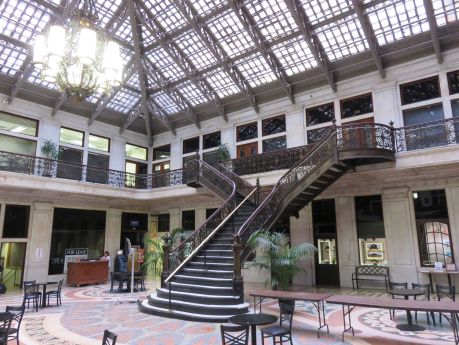
Ellicott Square Building was the nation’s largest office building when the 10-story Italian Renaissance-style office structure was built in 1896 at a cost of $3.5 million dollars. It’s most impressive features are the ornate central atrium and exquisite marble inlaid floors. http://www.ellicottdevelopment.com/portfolio/ellicott-square-building/
The Buffalo History Museum is another building that is as rich in its history as the exhibits contained within. Originally constructed in 1901 as the New York State pavilion for that year’s Pan American Exposition, it is the sole surviving permanent structure from the exposition. There are three floors of exhibits, ranging from vignettes of the native Americans who inhabited the area to bios of famous West New Yorkers who reached national acclaim, but truthfully, it was the vintage trains that had Russ’ heart tingling. We were lucky that a member of the local train society was there and turned on various trains that chugged across an exacting historical depiction of old Buffalo. https://en.wikipedia.org/wiki/Buffalo_History_Museum
Visiting the Pierce Arrow Museum was a no-brainer. Minutes from our hotel, it’s the only museum in the world with a car lot worth of original Pierce Arrow glamorous vehicles. I imagined myself as a Hollywood starlet, wearing my fur and draped languidly over some of the convertible models! The big draw for Russ though is that it also contains the only Frank Lloyd Wright Filling Station in the world. Lloyd designed the station in 1927 for downtown Buffalo but it was never built. Museum founder Jim Sandoro and architect, Patrick Mahoney tracked down the original blueprints and built the station inside the museum in 2013 as an ode to Wright’s futuristic design. There are two observation rooms, one with a fireplace. The genuine copper roof gleams. Innovations are apparent. Instead of attendants struggling to pump gas, Wright created two 45 foot poles he called “totems” for an overhead gravity-fed gas distribution system for fueling cars. Even if you aren’t as excited to see the filling station as much as we were, just browsing this collection of cars and extensive gift shop was worth every minute spent. Bonus, the museum can accommodate up to 500 for receptions. http://www.pierce-arrow.com/about.
We also visited many other architecturally-significant buildings in the area, but there are too many to describe. Suffice it to say that Buffalo has a treasure trove of architecture.
In Part 2, Restaurants, Attractions And Day Trips Are Described.
All photographs are by Russ Wagner.
Karen Kuzsel is a writer-editor based in the Orlando area who specializes in the hospitality, entertainment, meetings & events industries. She is a Contributing Editor-Writer for Prevue Magazine and is an active member of ILEA and MPI and is now serving on the 2015 – 2016 MPI Global Advisory Board for The Meeting Professional Magazine. Karen writes about food & wine, spas, destinations, venues, meetings & events. A career journalist, she has owned magazines, written for newspapers, trade publications, radio and TV. As her alter-ego, Natasha, The Psychic Lady, she is a featured entertainer for corporate and social events. karenkuzsel@earthlink.net; www.ThePsychicLady.com; @karenkuzsel; @thepsychiclady.

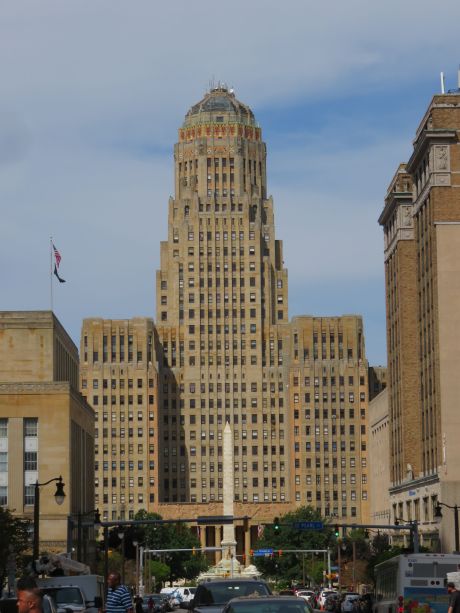

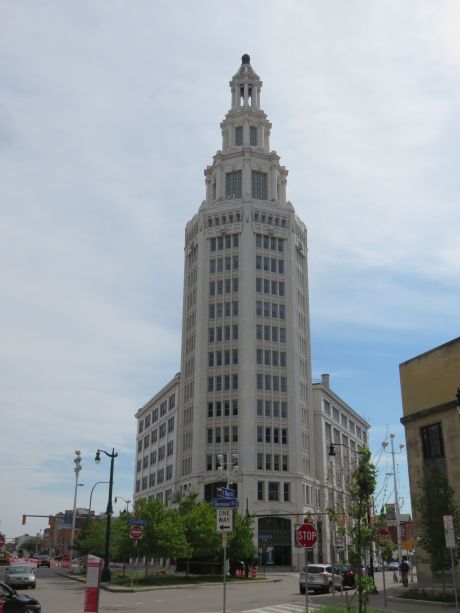
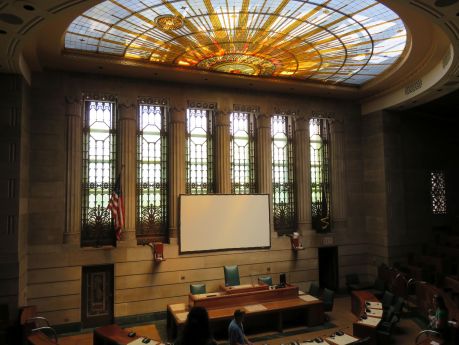


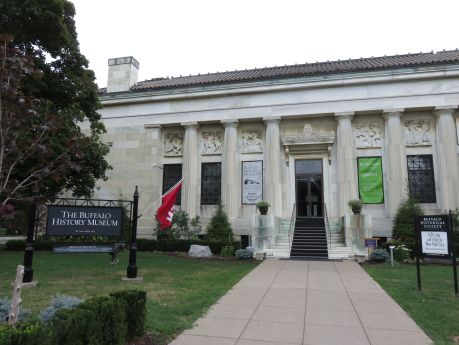

I am regular visitor, how are you everybody? This
piece of writing posted at this web site is truly good.
Thank you. What about my blog would cause you to return?